Article follows the photos. Click on a thumbnail to view and download a high-resolution version of the image. Due to the large file size of the high-res images, they may take a few minutes to appear. You must be logged in to view the high-res images. 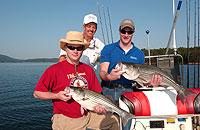
From left: Ian Harrod, John T. Hall and Jay Harrod (CH) 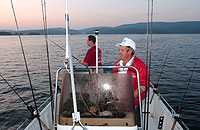
Sunrise on Lake Ouachita (CH) 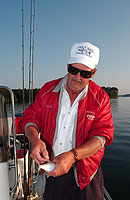
Hall baits the lines with shad. (CH) 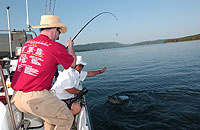
Ian struggles to land a striped bass. (CH) 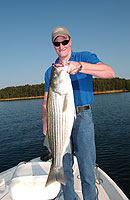
Harrod holding the last catch of the day (CH) June 13, 2003
Chasing the 'Big Ones'
Striper Fishing in Arkansas
*****
By Jay Harrod
Arkansas Department of Parks and Tourism
LAKE OUACHITA -- "Keep both hands on it," John T. Hall, our fishing guide for the day, instructs. "That's a $300 rod and reel, and a striper will jerk it into the water before you know it."
It's happened before, and John has a story to tell about a time when it did. Though the sun has yet to rise above the mountains surrounding 40,000-acre Lake Ouachita, I've already realized John has lots of stories. And he should. He started guiding on the Buffalo River in 1973, and he's been a full-time guide -- primarily at Lake Ouachita and Lake Hamilton -- for more than 12 years.
On this late-May morning, John has taken my brother, Ian, and me to a spot on Lake Ouachita where the day before his client landed a 30-pound striped bass -- the largest species of bass found in Arkansas's waters. After he anchors and as he baits the lines with shad he's netted on the Arkansas River, John tells us we'll be lucky to catch a fish here.
"But I want to give you a shot at the big ones," he says as he throws the live shad into the water. He's hooking the baitfish about 25 feet below slightly inflated balloons that will basically act as bobbers. Once in the water, the shad sometimes swim as far as 200 yards from the boat. Other lines he's rigged have no balloons, but sinkers that keep the shad directly below the boat -- in this case at a depth of about 45 feet.
Twenty minutes later and we haven't had a bite. Then John notices one of the balloons moving rapidly and changing directions. "Something is making him nervous," he says while pulling more slack from the reel. "Now remember, if he takes it, give it 10 seconds before you set the hook."
His instructions are interrupted by the sound of line whizzing from the spool. "One's got it," he exclaims. I take the rod, but I'm not quite sure if 10 seconds have passed. It doesn't matter; John yells, "now!"
I point the rod down towards the water, reel fast, and give it what I think to be an aggressive jerk. The rod bends, and I feel the fish diving. Seconds later, the rod is still bent, but there's no movement in the line now.
"He's gotten into the treetops," John says. "You let him dive too deep."
I'm hung, and that's the only bite we get at this spot where John thought our chances of landing a monster-sized striper were best. It's 6:30 a.m., and we've now been on the lake a little over an hour.
"All right," John says as he begins reeling in one of the six lines in the water. "Are you guys ready to catch some fish?"
We motor farther west, to a place where two former river channels meet. "Stripers use river channels like we use highways," John says. "They have a cruising speed of seven miles per hour and can have bursts of speed up to 18 miles per hour. They might be here today and at Brady Mountain [some 6 miles to the east] tomorrow."
But John, like the other experienced guides on Lake Ouachita, knows these fish. He knows where and what they were biting last month, last week and yesterday. And he knows where they'll be biting tomorrow -- even if an unusual north wind is blowing, as is true on the day of our trip.
Once there, John cruises around slowly, watching his depth finder, looking for changes in the underwater terrain and for fish, which can also show up on the graph. He locates the drop-off he sought and -- more importantly -- several stripers.
"See 'em?" he asks. "They look like inverted 'V's.'" I look at the graph, and then I watch as the images nearly blackout the screen.
"Fellows, they're all around us," John says as he works feverishly to bait the lines and get them in the water. Again he rigs "balloon lines" for us and then rigs the sinker lines on the other rods, which he places in holders. Seconds after the first sinker line is in place, we hear line being pulled from the reel. Neither Ian nor I have fished for stripers before, and it's obvious we have lessons to learn.
John grabs the rod, feeds it some slack, and then sets the hook before handing it to Ian, who is fumbling, looking for a holder in which to place his rod. "You guys have gotta be quicker than that," John says.
We prove to be quick learners, though. Shortly after Ian's bass is in the boat, I again hear line reeling. This time, I promptly grab it, feed it slack, wait a moment more, and then set the hook. The fight is on, and it's a feisty one, but because this fish was only some 40 feet below our boat, John is netting it about two minutes later. Like Ian's, this striper weighs -- by John's estimate -- about nine pounds.
There's not much time to gloat. Ian's balloon has just disappeared, and there's the sound of line whizzing from his spool, which by now draws my immediate attention and causes adrenaline to pump through my veins. He sets the hook, and his rod bends sharply. The fish is probably 100 yards from the boat, and the struggle to land it begins.
"Keep reeling!" John yells. "Don't let him have any slack. You'll lose him if you do." When the fish is in the boat, I watch as Ian rubs his arm and shakes his wrists. Catching a striper -- even a relatively small one -- is no easy task.
Thirty minutes after arriving at John's hot spot, I'm reeling in the fish that equals our limit for the day. But it proves to be the largest of the outing, and it took the bait some 150 yards from the boat, so the fight is long and hard.
Once in the boat, I hold it up for a photo. My arm is burning from the exertion, and I've burst a blood vessel in my hand. It's hard to imagine the struggle of catching a 30 pounder, let alone a 53-pound, 9-ounce striped bass, as did one of John's clients on Lake Hamilton in 1997. That fish set a new state record, but was beat four days later. Today the record stands at 64 pounds, 8 ounces, which was caught in 2000 in the White River, just below Beaver Lake.
While certainly not a new state record, this is the largest fish I've ever caught. I guess it to be "at least" 13 pounds. "Eleven, 10," John says, referring to pounds and ounces. We get a scale -- 11 pounds, 11 ounces. "I can always get to within four ounces," John says, smiling.
On Lake Ouachita, the limit for striped bass is three. According to John, stripers usually hit top-water baits in April and May, but this year they have not. If we were able to use top-water lures, John says we could continue fishing and release our catches alongside the boat. When fishing with shad, though, the stripers regularly swallow the hooks and they are almost always stressed due to fighting from such depths -- meaning they won't survive if let go.
But I'm satisfied with our catch and the fun we've had. That night, my family and I have a fish fry, and striper filets prove to be some of the best fish I've tasted. And for the next few days, I'm reminded of the excitement of striper fishing each time I laugh and agitate the bruises caused from wedging the rod against my stomach while landing those big ones.
About Striped Bass
Stripers are a saltwater species of bass that, like salmon, run up rivers to spawn. They can complete their lifecycle -- but not reproduce -- in freshwater, which means they must be continually stocked in Arkansas's waters. The Arkansas Game and Fish stocks striped bass in the Little River and in 10 lakes: Beaver Lake, DeGray Lake, De Queen Lake, Greers Ferry Lake, Lake Catherine, Lake Greeson, Lake Hamilton, Lake Maumelle, Lake Norfork and Lake Ouachita. Striped bass are also sometimes caught in the Arkansas River. Many of these lakes also have hybrid striped bass, which are a cross between striped bass and white bass and which are smaller but can reproduce in freshwater.
Fishing Guide Services in Arkansas
On most of the large lakes that are stocked with stripers there are several guides that offer guided fishing services. Many services are comparable to those offered by John Hall, who provides the boat, all necessary gear and the bait, and who cleans and filets the fish for his clients. For a half-day fishing trip, Hall charges $220 for one or two persons and $280 for three persons.
The Benefits of Swimming for Exercise
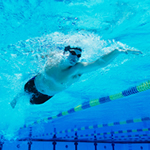
High Performance Freestyle Snowboard with Customised Brilliance

Be A Better Putter In These Three Simple Steps
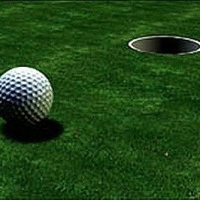
Copyright © www.mycheapnfljerseys.com Outdoor sports All Rights Reserved